Tools!!
Carpentry, Joinery, and Construction Tools:
Drilling
- Craftsman 1/2" drill - again, one of Craftsman's better offerings.
- Milwaukee 1/2" hammer drill:

The hammer action seems kinda wimpy, but it's a nice well-made compact drill -
and it will drill masonry, very very slowly. (I need to get a real rotary hammer.)
- Milwaukee C-122 drill - this is a huge OLD beat-up drill (triple-reduction
I suspect), which I bought for $5 at a garage sale in the 70s - but it just keeps on
turning. It's done enough jobs for me now that I feel I owe it faithful maintenance!
- Milwaukee 2404 drill -
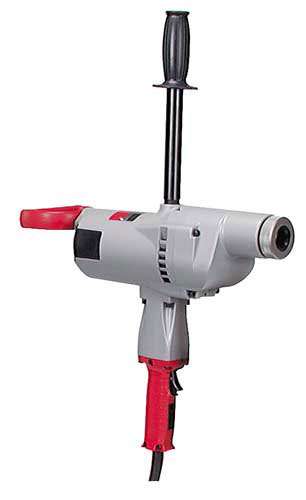
This comes with a 3 Morse Taper socket instead of a chuck, but I just had to put a chuck on it too...
Naturally the beercan-sized 20N, which will hold up to 1 inch bits!
Turning at 250 rpm it pulls a fair amount of torque - rated for 1.25 inch drilling in steel.
Sawing
- Skilsaw 77 -

the classic. Worm-drive is a lot friendlier for inexperienced carpenters.
It's heavy, but I think nothing beats it for cutting 2x4s etc.
- Makita 4200NH -
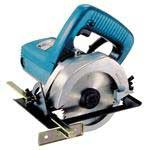
This is an oversexed little 4.375 inch circular saw, but it's quite powerful (9A motor).
It can't cut 2x4s, but it's just the ticket for cutting up sheet plywood.
- Super Sawzall

This is a great tool, and one of the reasons I like Milwaukee so well.
I've used and abused mine for many gnarly projects.
- Craftsman 10" Radial-Arm Saw: I'm wary of Craftsman power tools, but some of their best is very good stuff for the money. This one has lasted (and stayed accurate, with only very occasional adjustment) through many years.
- Back Saws: I don't think of these as very useful, but I do use them, so maybe I'd miss them if they were gone. My dovetail saws (like small back saws) are quite useful.
- Hand (crosscut) Saws: I still use the plain old-fashioned carpenter's saw pretty often, when I've got just one cut to do.
- Hacksaws - very convenient, just occasionally, for cutting thin surly materials.
(Maybe I should call this page "Truel Confessions"??)
- Pruning Saws: It's awesome how fast you can cut green wood with a sharp blade. Mostly I use them up
There was an article in Fine Woodworking long ago on green-wood joinery, and I'm still impressed by the idea of doing your rough cuts while they're easy.
Abrading
- Porter Cable 4x24 Belt Sander -

This is nice, solid, heavy, high-power, and not skittish.
*The dust bag isn't enough to help much in an unventilated space, but it makes a huge difference if you're outside or have reasonable ventilation.
- Craftsman 7" Body Sander - one of Craftsman's better offerings - this is so durable I suspect it of having been made by Milwaukee.
This is incredibly useful for all sorts of rapid-removal needs, including free-form wood sculpture.
- Waterstones, oilstones, etc. - but I've gone to wet sandpaper on glass for fine sharpening, and a sander for quick cleanup.
- Scraper - one of those classic woodworking tools any serious woodworker should try, once.
- I've got a little pneumatic cutoff wheel, which is nice for quick-and-dirty cutting of hard stuff - but I don't like it.
I guess the body just feels too small for good control of the wheel's position.
Fastening
- Remington powder driver: I got their cheapest model, since I don't need this
very often - but when you want to nail something into brick, there's NO substitute.
(Loud though.)
- Bostich Roofing Nailer - a nice solid little tool with good design.

Roofing nails (with their big heads and better corrosion resistance) are useful for
lots of odd jobs other than roofing.
- Yankee 131A Speed screwdriver -

this is an incredibly fast way to drive Phillips screws, and I find it works better than an electric driver.
(The bit is being pushed into the screw head hardest just when the screw is offering its maximum resistance.)
I need to find or make some Robertson bits for this.
- Paslode Framing Nailer - addictively useful.

Mine came with a nice fitted soft case, which will help it live as long as it should!
- Porter Cable Bammer Angle Finishing Nailer: This is one of the airless tools which runs on a little butane cartridge.
I like the idea, but this one hasn't worked out too well for me; I'd get Paslode if I were buying this again - the Porter Cable is built well, but the Paslode seems to be better designed.
I've tried using this in woodworking (e.g. to pin the back of a shelf to the back panel), but it's really happiest only with its designed job - nailing molding into place.
- Hammers: wooden handles just feel better. The difference between a regular carpenter's hammer and a framing hammer is considerable, and I may add a smaller claw hammer to my toolbox as well.
- Craftsman pneumatic stapler - kinda cheesey.
- Pop riveters - irresistably convenient for kludging.
- Glue gun
Other Cuts
- Porter Cable 557 Biscuit Joiner:

this improved model has MUCH better quality than PC's first attempt at this design.
- Porter-Cable 15A router - finally got a half-inch!

(The plain old Speedmatic, not the plunger.) Still building up my bit collection.
- Craftsman routers - these suck. Quarter-inch routers just don't make sense for most purposes.
- Record jointer and bench planes -

solid irons and a pleasure to use. I don't use these much, but they have a nice sentimental connection to older centuries.
I love the no.7, and just wish I'd gotten a no.8 while they were still available!
I've also got a jack plane and some cheesy block planes.
- Drawknife - an old-fashioned tool which takes a little care, but is very nice for quick cleanup of timber flaws (or, I'm told, for working green wood).
Its civilized brother the spokeshave has more day-to-day use, and is really very useful for quick light trimming of dowel or tenon joints.
- Chisels and Gouges
- Carton Knife - embarrassingly convenient for many small trimming jobs.
Holding
- Jorgenson parallel-jaw clamps - solid and a pleasure to use.
It's amazing, comparing these side by side with Craftsman, how different the feel is, and how easily the Craftsman units could have been built with better quality.
- Jorgenson 72xx bar clamps - these are good solid tools, built for forever.
I've got a pair of the 7296 (8' long!) which are just the thing if you're building a REALLY wide piece - I need to get some of the more portable small sizes!
I've got tons of pipe clamps too - the size that fits on 3/4" pipe is pretty useful, not so the ones that go on 1/2" pipe.
- Woodworking vises - I put a pair of these in parallel on an old workbench, and they really do a nice fast job of workpiece positioning.
Measuring etc.
- Marking gauge (Japanese-style, with a blade tip) - very useful for woodworking.
- Dial indicator - a really basic tool for diagnosing machinery.
- Nice small squares work more accurately, for me at least, than big sloppy squares.
(Sometimes machinist's tools are the best for close-tolerance woodworking.)
The clamps which are attached to a framing square for stair layouts, though, are useful for lots of other odd layout jobs.
- Micrometers - I hardly ever use these, but the design is a classic of 19th century ingenuity.
- Vernier Caliper - extremely useful, and has displaced micrometers for most uses where I don't need less than a couple mils of precision.
("Mil," kids, is a thousandth of an inch, i.e. 25 microns.)
Yard/Garden/Landscape/Arborist Tools:
Tree-climbing:
- Climbing Rope: Any climbing rope sold as such in the US is going to be good quality - the liability exposure in this industry is fierce. I just got a Samson TrueBlue climbing rope (braided polymer), and was surprised to find it's MUCH more slippery than my first (BlueStreak) rope had been. With this rope I'm starting to use false crotches a little less, since it's MUCH quicker to just throw your rope over the second big branch.
- Saddle: Tree saddles are different from fall arrest harnesses (e.g. those used
for rock-climbing), since a tree saddle may need to carry your weight comfortably
for a long time. Buckingham saddles are the best I know of, and I love mine
(Arbormaster II with top harness).
- Hardware: it's all damnably expensive, BUT when you've got the potential
to fall 75 feet from a single point of failure, cost is not the most important thing!
Currently my basic climbing kit is:
- Petzl ascenders
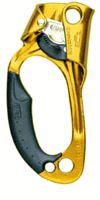
- I've started using these more for climbing - it's an inefficient but pleasant way to get some arm exercise).
- Petzl descender:
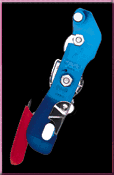
This exemplifies why I like Petzl: it's not only somewhat idiotproof, but also has
pictorial instructions engraved on it, which is really convenient for when you're
starting to get stupid from exhaustion and know you need to double-check things.
- Petzl microcenders:

These work well, but I'm currently experimenting with a Tenex tie-in line
instead.
- two pole straps (lanyards);
- an etrier (the fabric ladder);
- flipline; and
- Even the carabiners are expensive! Besides aluminum 'biners for climbing,
I've also started getting some steel ones for hoisting/lowering,
but I haven't started buying bull rope or other rigging accessories yet.
- For line placement I keep several throw weights and throwing line.
I've found initial line placement to be surprisingly difficult, at least in tree species with sharp-angled crotches.
I keep thinking there must be a better way;
I've experimented with using a slingshot and deep-sea fishing line,
but found that available fishing sinker weights weren't heavy enough to crash down through summer foliage.
(Hm, maybe I need to get a nautical line-throwing gun!)
- Climbers: I've got some Buckinghams I need to practice with -
but those aren't something to use on a prized residential tree.
Chainsawing:
- My main chainsaw is a Stihl 066M

-
What a speed queen!
For ripping I will sometimes mount a 36" bar (much longer than the one shown here) -
the 36" bar, while cumbersome, does reduce kickback risk, and this unit is (barely) powerful enough to rip with a 36 ripping chain (extra skip).
- I have a little climbing saw from Echo
 (CS-3400),
(CS-3400),
but I didn't get the best made: because arborist saws get dropped.
(Haven't dropped mine yet, but I probably will sooner or later.)
The Stihl 020T is a little beauty, but my Echo was less than half the price.
- My Stihl HT75 pole saw

is terrific for residential cleanup and brush pile reduction, but it'll sure get your deltoids tuned up!
- Maybe I've been overindoctrinated about kickback, but for chainsaw work I still wear:
safety chaps, safety shirt (or motorcycle jacket), motorcycle gloves, helmet, AND heavy leather boots.
Maybe I'll reduce the apparel load after my first 100 hours or maybe I won't -
it's easy to get stumbling-tired while chainsaw cutting.
- Peavey:

just as with Vise-Grips, the originator still does it best!
The wooden handle on this is about 3" thick at the point of maximum stress - I've broken off lots of pick handles, but I don't think I'll break this!
- Blower: I got the Redmax 6200

(62cc), and I love it: it's powerful enough that I've often used it to blow wet
leaves out of a swimming pool! I just wish somebody made a bigger one. (Redmax is a subsidiary of Komatsu, the bulldozer company, and their product engineering shows it.)
- Machetes: these really are a basic tool for reasoning with vegetables.
I like the ones with a finger guard - less chance of it flying when you're sweating and flailing.
I was surprised to find that it's useful to have more than one length (mechanical impedance-matching),
and now I'm curious to try the corn knife and cane knife variants too.
I've recently gotten a Gurkha kukri, and its heavy forward-curved blade should work very well for heavy chopping.
Other ethnic fighting knives seem to be adapted for machete uses too, now that I look at them (duh!).
- Brush axe (the kind with J-shaped SHARP flat blade on a 3 foot handle: this is just a bastard.
I tried it on bamboo, and I guess it would be very useful on blowdowns or really thick brush -
but that two-sided sharp blade seems dangerous to me, especially when I get it zooming.
(Also, on bamboo I wound up with VERY sharp stumps if I cut at an angle.)
You can buy a sheath for the blade, but still I find this tool more plausible as a pre-gunpowder war weapon (which it was) than as a clearing tool.
- Axes: I think the classic single-bitted axe is a beautiful piece of folk ergonomics, and a model for most large striking tools.
I learned how to use and sharpen an axe in Boy Scouts, and I still cherish that competence (despite having NO practical need for it in recent decades).
- Hedge Trimmer: again, I got Redmax's biggest - a 40" single-sided model,

which is great for rapidly flattening or levelling large hedge surfaces.
It's only 23cc, but is undaunted by even very woody brush - it will
actually saw through any branches it can't just cut.
(Unlike any other hedge trimmer, it has chisel tips on the outer ends of its teeth -
makes it a bad thing to run into, but good at sawing through branches.)
- Weed and Brush Cutter: again, I got Redmax's biggest

(BC4400), which has a 42cc engine. The only thing bigger is the Stihl 550 (which I sometimes look at in catalogs - ain't no harm in looking, is there??) For routine trimming I like to run a fixed-line head with .155" line - makes a pretty potent combo. The Stihl deluxe harness makes this very comfortable, and is well worth the money. When there's tough stuff to cut a blade works great -
this devours mature bamboo, and clears mesquite saplings up to 2" or maybe
3" easily enough.
- Trash pump: I've found that my half-horse cast-iron trash pump can be used for hydro-excavating: start an elongated hole which is wide enough for two pumps, then just let this pump sit (alternately) in one side of the hole and run while you wash dirt into it from the other.
- Picks, pick-axes, and mattocks: I sort of like grubbing stumps - there are always surprises under the surface, and the exercise is a nice combination of fast and slow. You not only hit as hard as you can, but when you're prying you get to pull hard too. Cheap mattocks will bend, but good railway picks will take as much pull as I can give.
- The "San Angelo bar" is a surprisingly useful fencing tool: it's a heavy steel bar with a sharp point, made for breaking rocks in a posthole.
- A stake driver is a very useful specialized tool for
pounding stakes into hard ground - a sledge really can't substitute for this.
(Basically it's a piece of heavy pipe with 20 pounds or so of weight and handles
on the sides.)
- Atlas Copco jackhammer - I've got a little TEX18PS 20-kilo model - seems
nice, but it clearly needs a test drive - maybe the back driveway would look better
as a flower bed.

Mechanic's Tools:
- 1/4"-drive: I don't use 1/4" much, but when you need it it's irresistable!
- One nice use for 1/4" (or 3/8") is to chuck a cut-off extension in an air drill, when you want a really fast light driver.
- Another nice unique capability in 1/4" is the flex-shaft driver.
- 3/8"-drive: the main size for automotive and light work, and probably the size where the most thoughtful tool designs are found.
- The classic folding-head ratchet with the handle angled at 15 or so degrees is just great ergonomics.

- The air-assisted ratchet is convenient for the hand feel of manually breaking
or torquing down - but the air-assisted ratcheting is loud and not all that fast. I find
the no-frills 3/8" impact driver to be much more useful.
- 1/2"-drive: also a reasonable choice for automotive, with much heavier capabilities for occasional truck work.
Some people (like me) just plain like the extra beef: torque capability goes up roughly as the CUBE of the drive size, so 1/2" has more than twice the strength of 3/8. Still, 3/8" is more elegant!
- Snap-On 1/2"-drive 24" breaker bar - when you're upside down in a backbend trying to get torque on a pesky bolt, this will do it.
- Snap-On SN4A
 is a really nice combination of breaker and speeder.
is a really nice combination of breaker and speeder.
- 3/4"-drive: A nice transitional size which covers a lot of truck and equipment work.
3/4" can handle up to 800 lb-ft., which is almost (but not quite) all you'd want to do by hand.
- Craftsman socket set
- Craftsman breaker
- Craftsman ratchet
- Snap-On ratchet: a treasured souvenir from my diesel mechanic days, when it was my last-ditch persuader.
- 1"-drive: The basic size for heavy mechanics; I used to lust after these in my diesel mechanic days.
This size will handle ANY torque you can apply by hand, and has lots of capability for use with geared wrenches, slugging wrenches, etc.
- Ingersoll-Rand IR293 super-heavy-duty impact wrench: a nice little 2000 lb-ft nut-buster.
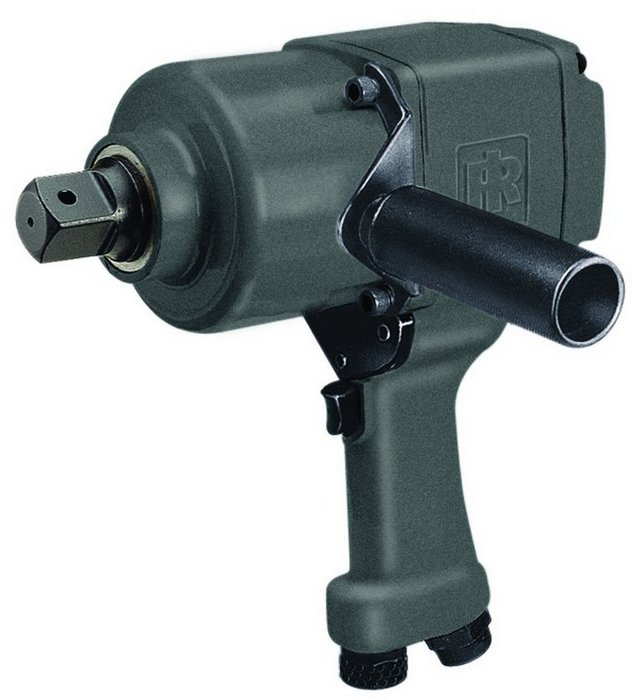
- Snap-On 2000 lb-ft torque wrench (TEQ2003?)

- Snap-On ratchet with 3' handle

- Lots of fine impact sockets
- Chinese no-name set of chrome sockets (I kick myself when I buy from a country that uses slave labor to make export goods, but sometimes I slip.)
- 1.5"-drive: This is total berserk overkill!
The best rationalization I've been able to come up with is to use it on railroad maintenance (I do belong to the SW RR Historical Society, which runs the very nice train museum in Dallas.)
This size is basically for machine operation, and the hand tools are just for checking or snugging.
- Impact wrench (of unknown Japanese manufacture): 10,000 lb-ft. of torque, about the size and weight of a 90-pound jackhammer. It's the dead spitting image of the IR 5980A1
 with the 5980-48 Dual Grip handle accessory - but it says "made in Japan."
with the 5980-48 Dual Grip handle accessory - but it says "made in Japan."
- Hand ratchet: this is a Lowell model 28 ratcheting wrench (4-point 1.5" female), fitted with custom plug adapter to drive 1.5" sockets.
- About 22 different impact sockets, regular and deep, up to 3-3/4" or so.
- Swivel connector
- Adapters to and from 1" drive
- Two extensions (even extensions in this size are massive and expensive!)
- 72" steel pry bar: you'd be amazed how easy it is to move around 5
or 10-ton objects with this (IF you can get the right leverage).
- 2 lb. Rubber-head mallet: this is unbelievably useful.
I wish a larger range of weights were available.
This is far less destructive than even the soft-faced hammers - it's just unbeatable for smacking almost anything (inanimate) into its place
- Pullers etc.: lots of Owatonna (OTC), which are not bad, but Snap-On are just so cool!
Bearing separators go with them.
- Slide Hammer: a hammer that works backward -
 - something you may not have heard of if you haven't done some wrenching.
- something you may not have heard of if you haven't done some wrenching.
- Service Jack: I've got a Jet 5-ton, which is sweet
 - I just need a semi to work on occasionally!
I've also got two smaller sizes - these are nice tools with some surprising uses.
- I just need a semi to work on occasionally!
I've also got two smaller sizes - these are nice tools with some surprising uses.
- Jack Stands: not the place to scrimp. I've got two good-quality pairs, and occasionally like to take my kids for an "air drive."
- Hammers: I've got ball-peins from 2 oz. up to 3 lb., and they ALL have a place: the weight of the hammer corresponds to a difference in source impedance.
Roughly, as between equal-energy blows, a lighter hammer is more likely to break something, or move the piece closest to the impact; a heavier hammer is more likely to deform something, or to move pieces further from the impact.
- Sledges: again, I've got all sizes (4, 6, 8, 10, 12, 16 and 20 pounds), and every one has its use.
- Winches: I've found that cheap little 1000-lb come-alongs are enormously useful, especially in groups. I've also got tree straps etc., and also a nice heavy Caterpillar swivel block for double-blocking...
- Auto ramps - useful for loading and odd height adjustment needs, as well as for seeing the dark side.
Metalworking:
- Anvil: I have an old 200-lb Fisher cast anvil - not a spring chicken, but has a flat
top and nice clean edges.
- Leg vise - around 150 lb.
- Lots of handled and hardie tools -
- I've got a propane burner, now I need to set up a forge!
- Taps, dies, etc. are useful for rethreading, but tapping-from-scratch is a much more serious job.
- Boltcutters, 18", 24", and 42".
- Miles of files
- Punches and chisels
Cleanup etc.:
- Shop vacs
- Magnetic "broom" for metal scavenging
- Aliphatic hand cleaner
- Abrasive hand cleaner
- Buffer wheels:
Needs list:
(These aren't frivolous wishes, these are tools that I really really need (ya
right):
- Scythe: like the single-bitted axe, the scythe and snath make a beautifully graceful ergonomic miracle - you won't believe how easy these are to use until you try one!
I've found a gorgeous web site (http://www.scythesource.com/) which anyone curious should check out.
- Welder: First I need to get one of those cheapo 225A Lincolns to get my hand in again.
- Bridgeport
- Wood lathe
- Table or ripping saw: I've tried to do without one of these for years (by buying dimensioned stock), but accurate ripping is just too fundamental to good woodworking. Table saws scare me, so I'm inclined to get one with a big table (more workpiece stability and more room around the blade), or possibly buy or build a ripping saw (which is much safer, but can't do angled edges).
- Bandsaw
- Wood Shaper: This tool has very nice stability and safety features, but I don't think the small sizes make sense for many applications. (I used to have Craftsman's best....)
- Drill Press
- Power Auger:
- Rototiller: Troybilt is very expensive, but owned by MTD now - BCS seems to be the high-end choice now.
- Tractor Jack
- More Robertson-bit drivers -
Robertson just makes more sense than Philips to me, and doesn't seem to demand as good metallurgy as hex socket-head screws.
(I'm told that true "Robertson" bits are supposed to have some taper,
and are not quite the same as "square drive" bits.)
- Pressure washer
- Lye tank
- Arbor press
All text on this web page is protected by copyright ©, and may not be reproduced without permission.
















 (CS-3400),
(CS-3400),






 is a really nice combination of breaker and speeder.
is a really nice combination of breaker and speeder.

 with the 5980-48 Dual Grip handle accessory - but it says "made in Japan."
with the 5980-48 Dual Grip handle accessory - but it says "made in Japan."
 - something you may not have heard of if you haven't done some wrenching.
- something you may not have heard of if you haven't done some wrenching.